Spanish -ar Verbs: Complete Grammar Guide

Written by
Ernest Bio Bogore

Reviewed by
Ibrahim Litinine
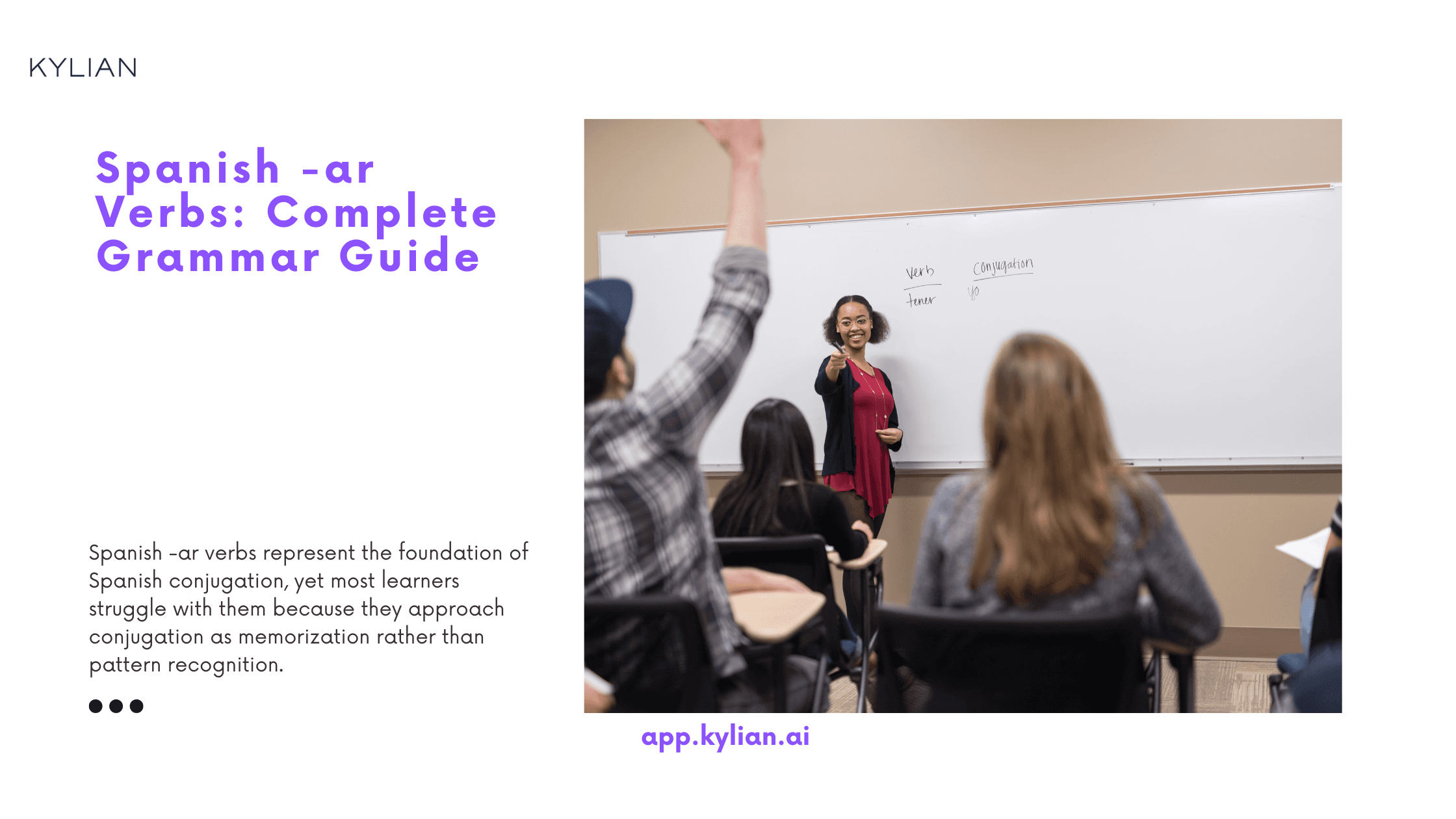
Spanish -ar verbs represent the foundation of Spanish conjugation, yet most learners struggle with them because they approach conjugation as memorization rather than pattern recognition. This systematic breakdown will transform how you understand and use these essential verbs.
What Are -ar Verbs in Spanish Grammar?
Spanish -ar verbs constitute the largest group of regular verbs in the language, accounting for approximately 90% of all Spanish verbs. These verbs follow predictable conjugation patterns that, once mastered, unlock the ability to communicate hundreds of actions and states.
The -ar designation comes from the infinitive ending. When you see caminar (to walk), estudiar (to study), or cocinar (to cook), you're looking at -ar verbs. This classification system exists because Spanish verbs change their endings based on who performs the action and when it occurs—a concept called conjugation.
Understanding why this matters requires recognizing that Spanish verb conjugation carries more information than English. While English relies heavily on helper words and context, Spanish embeds the subject and timing directly into the verb itself. This efficiency makes Spanish precise but demands systematic learning of conjugation patterns.
Present Tense Conjugation of -ar Verbs
The present tense forms the cornerstone of Spanish communication. Every -ar verb follows the same pattern: remove the -ar ending and add specific endings based on the subject.
The conjugation pattern works as follows:
- Yo (I): -o
- Tú (you, informal): -as
- Él/ella/usted (he/she/you formal): -a
- Nosotros/nosotras (we): -amos
- Vosotros/vosotras (you all, Spain): -áis
- Ellos/ellas/ustedes (they/you all): -an
This pattern applies universally to regular -ar verbs. Take estudiar (to study): yo estudio, tú estudias, él estudia, nosotros estudiamos, vosotros estudiáis, ellos estudian.
The power of this system becomes evident when you realize that learning one pattern gives you access to thousands of verbs. Cocinar becomes yo cocino, tú cocinas, and so forth. Caminar follows the same pattern: yo camino, tú caminas.
Critical insight: The first person singular always ends in -o for regular verbs. This consistency provides a reliable anchor point for conjugation. When you encounter yo trabajo (I work), yo nado (I swim), or yo bailo (I dance), the -o ending confirms you're dealing with the first person singular present tense.
Understanding the Verb Gustar (To Like)
Gustar represents a paradigm shift for English speakers because it functions backwards from English logic. Rather than saying "I like chocolate," Spanish says "chocolate is pleasing to me" (me gusta el chocolate).
This construction requires understanding that gustar agrees with the thing being liked, not the person doing the liking. When you like one thing, use gusta. When you like multiple things, use gustan.
Me gusta la música (I like music) uses gusta because música is singular. Me gustan los libros (I like books) uses gustan because libros is plural. The me doesn't change—it indicates who experiences the liking.
This pattern extends to other pronouns: te gusta (you like), le gusta (he/she/you formal likes), nos gusta (we like), os gusta (you all like, Spain), les gusta (they/you all like).
For negation, place no before the entire construction: no me gusta el café (I don't like coffee), no me gustan las verduras (I don't like vegetables).
The significance of mastering gustar extends beyond expressing preferences. It introduces the concept of indirect object pronouns and prepares learners for similar constructions with verbs like encantar (to love), molestar (to bother), and faltar (to lack).
The Imperfect Tense of -ar Verbs
The imperfect tense describes ongoing or habitual actions in the past without specific time boundaries. English often uses "used to" or "was/were + -ing" to express similar concepts, but Spanish handles this more elegantly through conjugation.
Regular -ar verbs follow this imperfect pattern:
- Yo: -aba
- Tú: -abas
- Él/ella/usted: -aba
- Nosotros/nosotras: -ábamos
- Vosotros/vosotras: -abais
- Ellos/ellas/ustedes: -aban
Estudiar in the imperfect becomes: yo estudiaba, tú estudiabas, él estudiaba, nosotros estudiábamos, vosotros estudiabais, ellos estudiaban.
The imperfect serves specific narrative functions. Cuando era niño, jugaba fútbol todos los días (When I was a child, I used to play soccer every day) sets up a habitual past action. Mientras estudiaba, sonaba música (While I was studying, music was playing) describes simultaneous ongoing actions.
Notice the accent placement: only nosotros/nosotras carries an accent in the imperfect (estudiábamos). This distinguishes it from other tenses and maintains proper pronunciation stress.
The imperfect's power lies in its ability to create vivid background descriptions and establish context for past events. Master this tense to elevate your storytelling and descriptive abilities in Spanish.
The Preterite Tense of -ar Verbs
The preterite tense expresses completed actions in the past with defined time boundaries. Unlike the imperfect's ongoing nature, the preterite pinpoints specific moments or completed events.
Regular -ar verbs follow this preterite pattern:
- Yo: -é
- Tú: -aste
- Él/ella/usted: -ó
- Nosotros/nosotras: -amos
- Vosotros/vosotras: -asteis
- Ellos/ellas/ustedes: -aron
Estudiar in the preterite: yo estudié, tú estudiaste, él estudió, nosotros estudiamos, vosotros estudiasteis, ellos estudiaron.
The preterite/imperfect distinction creates meaning differences. Estudié matemáticas (I studied mathematics) suggests a completed period of study. Estudiaba matemáticas (I was studying/used to study mathematics) implies ongoing or habitual study without completion emphasis.
Critical accent placement: first person singular (estudié) and third person singular (estudió) require accents to distinguish them from present subjunctive forms. This accent difference prevents confusion between yo estudié (I studied) and que yo estudie (that I study).
The preterite enables precise temporal communication. Ayer terminé el proyecto (Yesterday I finished the project) specifies exactly when completion occurred. This precision makes the preterite essential for clear narrative sequencing.
Irregular -ar Verbs: Estar and Dar
While most -ar verbs follow regular patterns, estar (to be) and dar (to give) demand special attention due to their irregular conjugations and high frequency of use.
Estar (To Be)
Estar indicates temporary states, locations, and ongoing conditions. Its present tense conjugation breaks regular -ar patterns: estoy, estás, está, estamos, estáis, están.
The preterite of estar is completely irregular: estuve, estuviste, estuvo, estuvimos, estuvisteis, estuvieron.
Estar enables precise state descriptions. Estoy cansado (I am tired) describes a temporary condition. Estoy en casa (I am at home) indicates current location. Estamos estudiando (We are studying) forms the present progressive tense.
The ser/estar distinction represents one of Spanish's most sophisticated grammatical concepts. Estar handles changeable conditions while ser addresses permanent characteristics.
Dar (To Give)
Dar follows irregular patterns across multiple tenses. Present tense: doy, das, da, damos, dais, dan. Notice the first person singular doy instead of expected dao.
Preterite conjugation: di, diste, dio, dimos, disteis, dieron. These forms share no resemblance to regular -ar preterite patterns.
The subjunctive forms of dar require accent marks to distinguish them from prepositions: dé (that he/she give) versus de (of/from). This distinction prevents grammatical ambiguity.
Dar appears in numerous idiomatic expressions: dar las gracias (to thank), dar un paseo (to take a walk), dar miedo (to frighten). These expressions demonstrate how irregular verbs often carry extended meanings beyond their basic definitions.
Complete Conjugation Reference for Regular -ar Verbs
Understanding all major tenses provides complete communicative flexibility. Using trabajar (to work) as the model verb:
Present: trabajo, trabajas, trabaja, trabajamos, trabajáis, trabajan
Present Progressive: estoy trabajando, estás trabajando, está trabajando, estamos trabajando, estáis trabajando, están trabajando
Preterite: trabajé, trabajaste, trabajó, trabajamos, trabajasteis, trabajaron
Imperfect: trabajaba, trabajabas, trabajaba, trabajábamos, trabajabais, trabajaban
Future: trabajaré, trabajarás, trabajará, trabajaremos, trabajaréis, trabajarán
Conditional: trabajaría, trabajarías, trabajaría, trabajaríamos, trabajaríais, trabajarían
Imperative: trabaja, trabaje, trabajad, trabajen
Present Subjunctive: trabaje, trabajes, trabaje, trabajemos, trabajéis, trabajen
This comprehensive conjugation system enables expression of any temporal relationship or modal nuance. The future tense (trabajaré mañana - I will work tomorrow) handles future plans. The conditional (trabajaría si pudiera - I would work if I could) expresses hypothetical situations.
The subjunctive opens entirely new communicative possibilities by expressing doubt, emotion, desire, and hypothetical situations. Espero que trabajes bien (I hope you work well) uses the subjunctive to express hope about another person's actions.
Advanced Patterns and Regional Variations
Spanish -ar verb usage varies significantly across regions, particularly with vosotros forms. Spain uses vosotros conjugations (trabajáis, trabajabais), while Latin American countries prefer ustedes for both formal and informal plural address.
This regional difference affects conjugation choices but doesn't alter the underlying patterns. Whether you use vosotros trabajáis (Spain) or ustedes trabajan (Latin America), the conjugation logic remains consistent.
Dialectal variations also appear in accent placement and pronunciation. Some regions pronounce final consonants differently, but written conjugation patterns remain standardized across all Spanish-speaking countries.
Advanced speakers recognize that -ar verbs often carry subtle meaning differences through aspect and mood choices. Trabajé (I worked) emphasizes completion, while trabajaba (I was working/used to work) emphasizes process or habit. These nuances separate intermediate from advanced proficiency.
Common Mistakes and How to Avoid Them
The most frequent error involves first person singular confusion. Learners often produce yo trabaja instead of yo trabajo. Remember: first person singular always ends in -o for regular verbs in present tense.
Accent mark omission creates serious errors. Trabajé (I worked) versus trabaje (that I work) represent different tenses and moods. The accent distinguishes preterite from subjunctive, preventing communication breakdowns.
Gustar constructions challenge English speakers who try to force English logic onto Spanish structure. Remember that gustar agrees with the thing liked, not the person liking. Me gustan los perros (I like dogs) uses gustan because perros is plural.
Preterite/imperfect confusion stems from English's limited past tense system. Spanish requires choosing between completed actions (preterite) and ongoing/habitual actions (imperfect). Estudié dos horas (I studied for two hours - completed) versus estudiaba cuando llegaste (I was studying when you arrived - ongoing).
Practical Application Strategies
Systematic practice accelerates -ar verb mastery. Begin with high-frequency verbs: hablar (to speak), caminar (to walk), estudiar (to study), trabajar (to work), cocinar (to cook). These verbs appear in daily conversation and provide maximum learning return.
Create conjugation charts for each tense, focusing on pattern recognition rather than individual verb memorization. Once you internalize the -ar patterns, application becomes automatic.
Practice temporal relationships through narrative exercises. Describe daily routines using present tense, childhood memories using imperfect, and specific past events using preterite. This contextual practice reinforces appropriate tense selection.
Integrate irregular verbs (estar, dar) into regular practice since their high frequency demands automatic recall. These verbs appear in countless expressions and grammatical constructions.
Learn Any Language with Kylian AI
Private language lessons are expensive. Paying between 15 and 50 euros per lesson isn’t realistic for most people—especially when dozens of sessions are needed to see real progress.
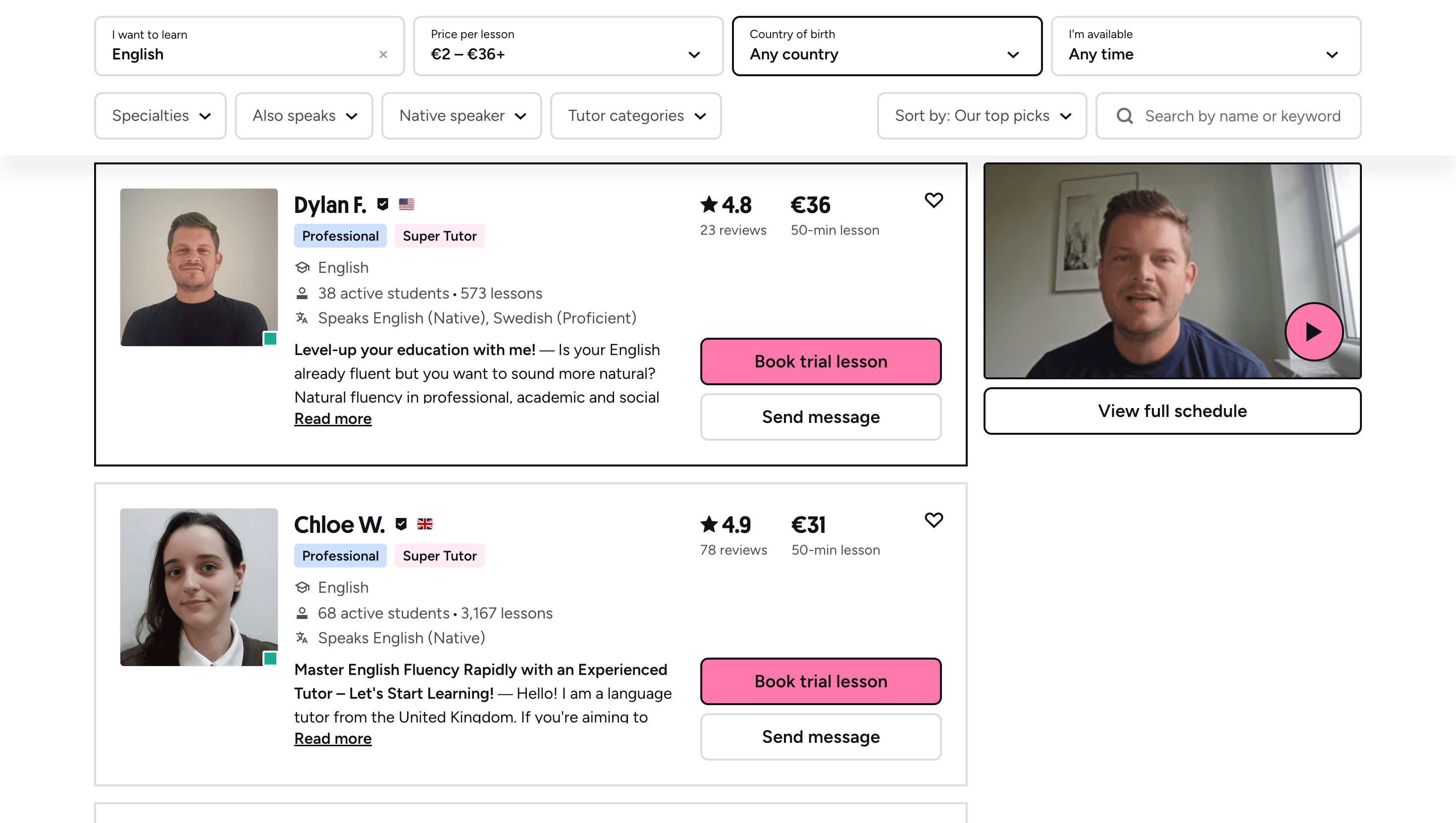
Many learners give up on language learning due to these high costs, missing out on valuable professional and personal opportunities.
That’s why we created Kylian: to make language learning accessible to everyone and help people master a foreign language without breaking the bank.
To get started, just tell Kylian which language you want to learn and what your native language is
Tired of teachers who don’t understand your specific struggles as a French speaker? Kylian’s advantage lies in its ability to teach any language using your native tongue as the foundation.
Unlike generic apps that offer the same content to everyone, Kylian explains concepts in your native language (French) and switches to the target language when necessary—perfectly adapting to your level and needs.

This personalization removes the frustration and confusion that are so common in traditional language learning.
Choose a specific topic you want to learn
Frustrated by language lessons that never cover exactly what you need? Kylian can teach you any aspect of a language—from pronunciation to advanced grammar—by focusing on your specific goals.
Avoid vague requests like “How can I improve my accent?” and be precise: “How do I pronounce the R like a native English speaker?” or “How do I conjugate the verb ‘to be’ in the present tense?”
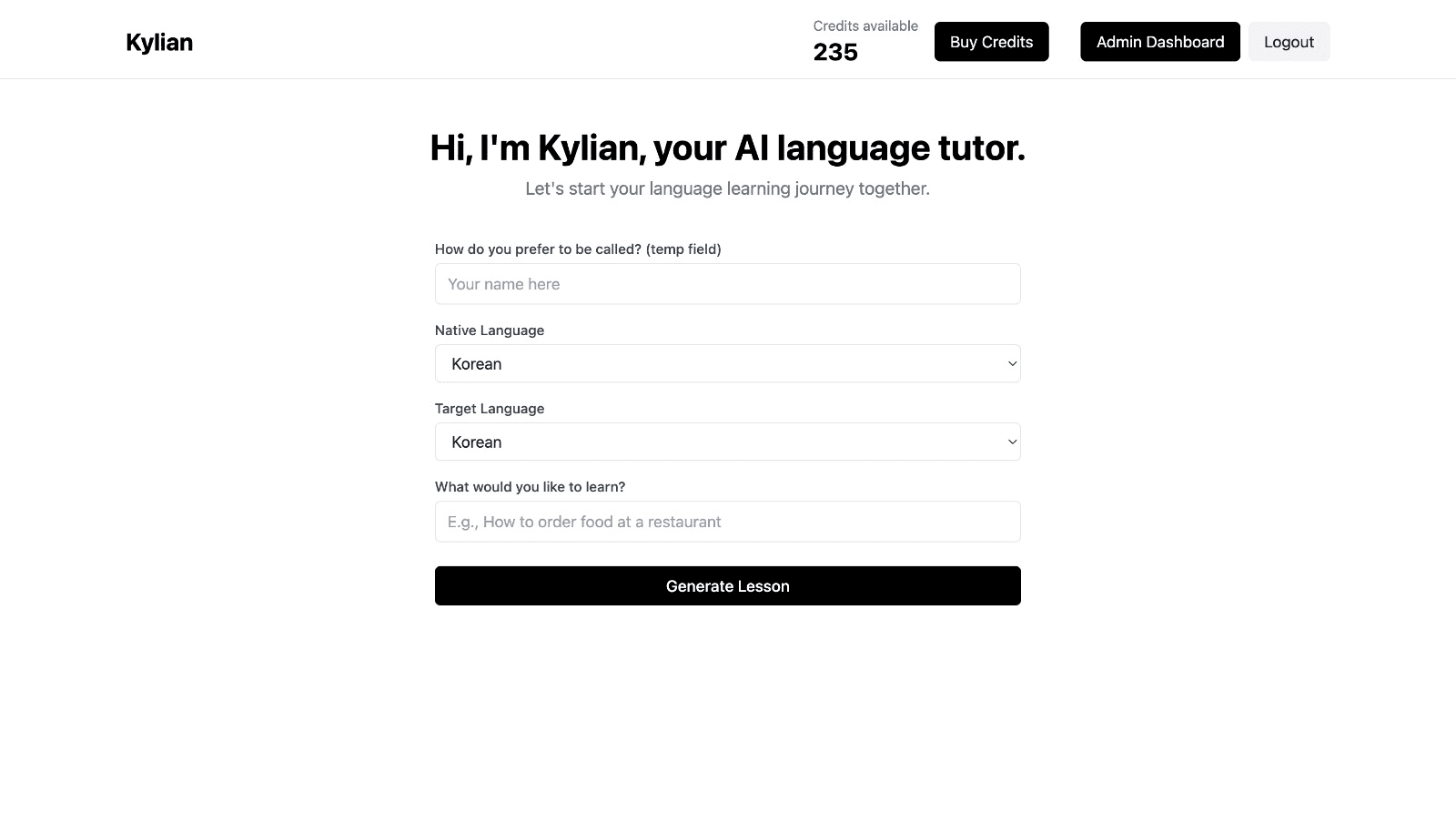
With Kylian, you’ll never again pay for irrelevant content or feel embarrassed asking “too basic” questions to a teacher. Your learning plan is entirely personalized.
Once you’ve chosen your topic, just hit the “Generate a Lesson” button, and within seconds, you’ll get a lesson designed exclusively for you.
Join the room to begin your lesson
The session feels like a one-on-one language class with a human tutor—but without the high price or time constraints.
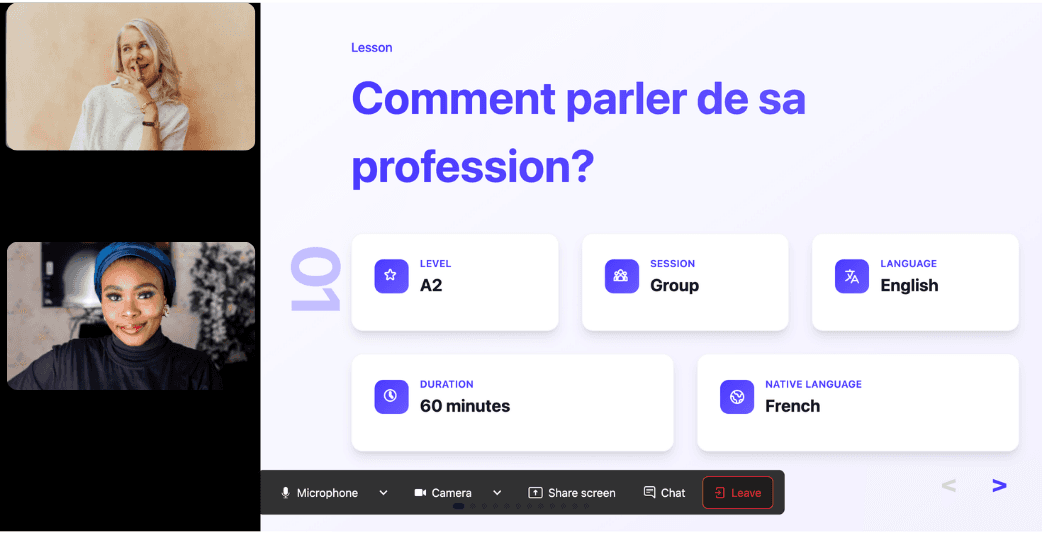
In a 25-minute lesson, Kylian teaches exactly what you need to know about your chosen topic: the nuances that textbooks never explain, key cultural differences between French and your target language, grammar rules, and much more.
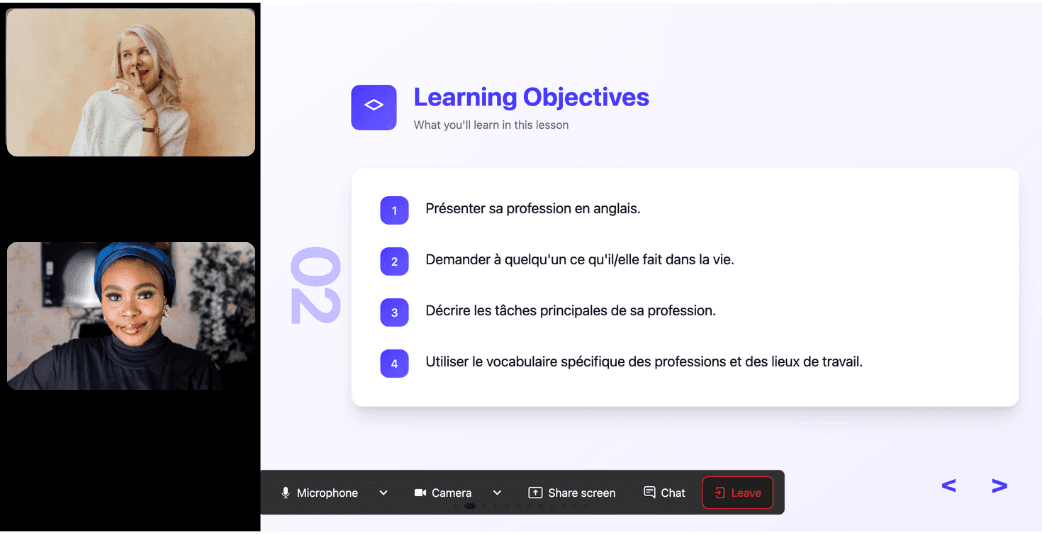
Ever felt frustrated trying to keep up with a native-speaking teacher, or embarrassed to ask for something to be repeated? With Kylian, that problem disappears. It switches intelligently between French and the target language depending on your level, helping you understand every concept at your own pace.
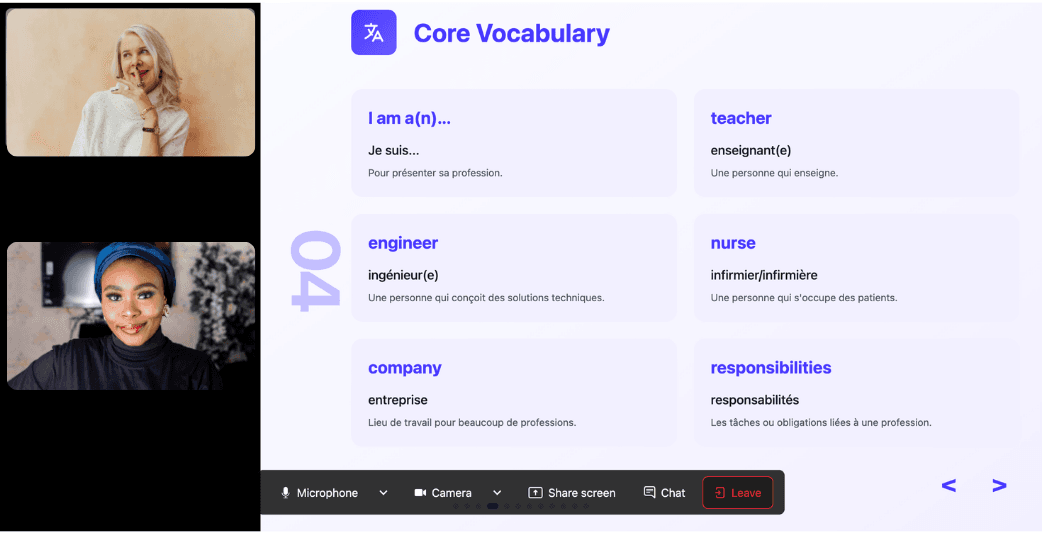
During the lesson, Kylian uses role-plays, real-life examples, and adapts to your learning style. Didn’t understand something? No problem—you can pause Kylian anytime to ask for clarification, without fear of being judged.
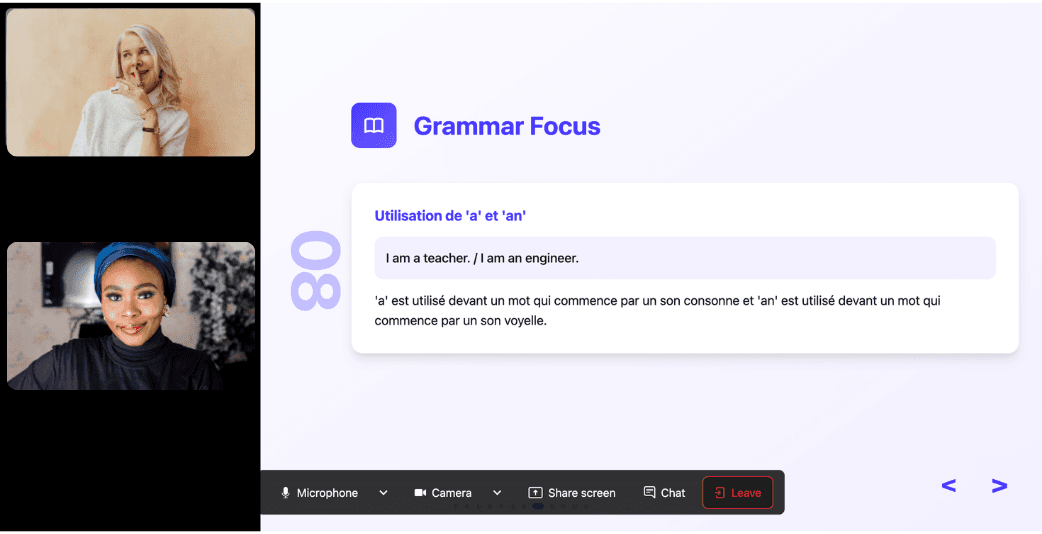
Ask all the questions you want, repeat sections if needed, and customize your learning experience in ways traditional teachers and generic apps simply can’t match.

With 24/7 access at a fraction of the cost of private lessons, Kylian removes all the barriers that have kept you from mastering the language you’ve always wanted to learn.
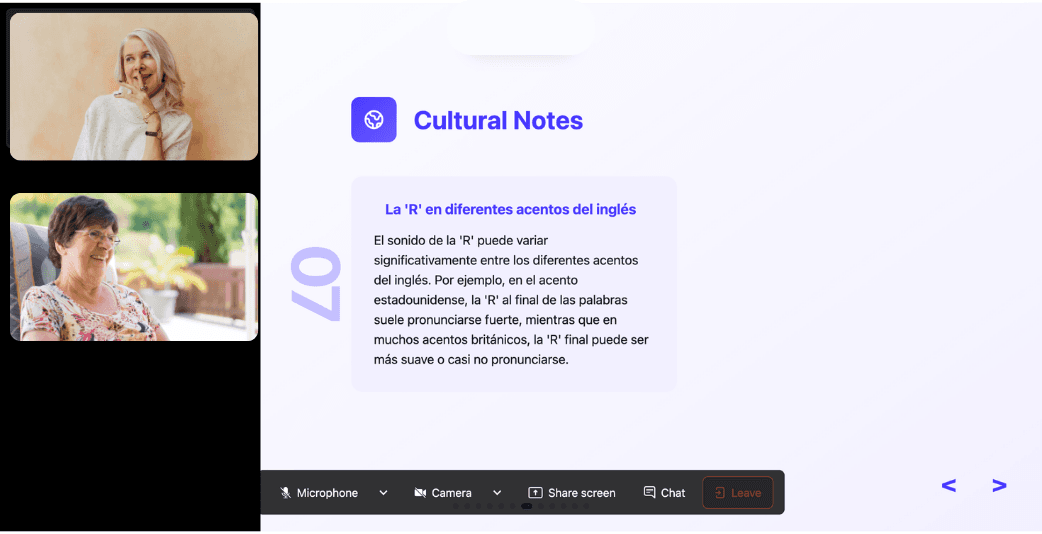
Similar Content You Might Want To Read

Essential Spanish Grammar: Your Complete Guide
Learning Spanish requires understanding its grammatical foundation—the structural framework that allows you to communicate effectively. Rather than viewing grammar as a collection of rules to memorize, consider it the blueprint that enables you to express yourself accurately in this beautiful language. This comprehensive guide breaks down essential Spanish grammar concepts into digestible sections, giving you a practical reference you'll return to throughout your language journey.

Spanish Stem-Changing Verbs: Complete Guide
Spanish learners often hit a wall when they encounter stem-changing verbs. After mastering regular conjugations, discovering that certain verbs transform their very core seems like an unnecessary complication. Yet this grammatical feature exists in Spanish for specific phonetic and historical reasons that make the language more fluid and natural to speak. Understanding stem-changing verbs isn't optional—these verbs include some of the most frequently used words in Spanish conversation. Research shows that the top 100 most common Spanish verbs include at least 15 stem-changing varieties, making them essential for functional communication rather than academic exercise.

Spanish Irregular Verbs: Essential Conjugation Guide
Learning Spanish requires mastering verb conjugation, with irregular verbs presenting a particular challenge for language learners. While regular verbs follow predictable patterns, irregular verbs march to their own beat, requiring dedicated practice and memorization. This comprehensive guide breaks down the essentials of Spanish irregular verbs, providing conjugation charts and practical examples to accelerate your language journey.

Spanish Pronouns: Complete Guide for Learners
Spanish pronouns represent one of the most fundamental yet complex aspects of the language that directly impacts communication effectiveness. Unlike English, where pronoun usage follows relatively straightforward patterns, Spanish pronouns carry gender distinctions, formality levels, and positional rules that fundamentally alter meaning and social context. The critical difference lies not just in memorizing forms, but understanding how pronoun selection affects the entire communicative framework. When you choose between "tú" and "usted," you're not simply selecting a word—you're establishing social hierarchy, regional identity, and relationship dynamics that native speakers decode instantly. Mastering Spanish pronouns eliminates the repetitive noun usage that marks non-native speech patterns. Consider the difference between "María trabaja en la oficina. María estudia español. María vive en Madrid" versus "María trabaja en la oficina. Ella estudia español. Vive en Madrid." The second version flows naturally while the first signals incomplete language acquisition.

Master the Spanish Subjunctive: Your Complete Guide
The subjunctive mood in Spanish strikes fear into the hearts of many language learners. Yet, this grammatical feature is essential for anyone seeking to express nuanced thoughts in the world's second-most spoken native language. Without it, communicating doubts, possibilities, emotions, and hypothetical situations becomes nearly impossible. This comprehensive guide will demystify the Spanish subjunctive, transforming it from an intimidating obstacle into a powerful tool for authentic expression. With clear explanations, practical strategies, and relevant examples, you'll gain the confidence to use this grammatical structure naturally in conversation. Ready to elevate your Spanish to the next level and communicate with greater precision? Let's begin.

Spanish Question Marks Unveiled: A Complete Guide
When learning Spanish, most students focus on vocabulary and verb conjugations while overlooking one of the language's most distinctive features: its unique punctuation system. The inverted question mark (¿) stands as an iconic symbol of written Spanish, yet many learners struggle to apply it correctly. This comprehensive guide explores the proper usage of Spanish question marks and other essential punctuation elements that distinguish Spanish writing. Understanding these nuances elevates your written communication from merely functional to authentically native.